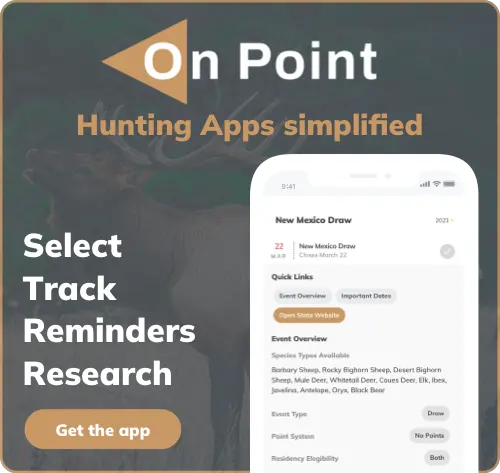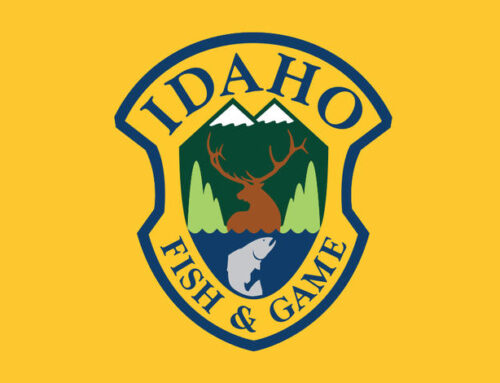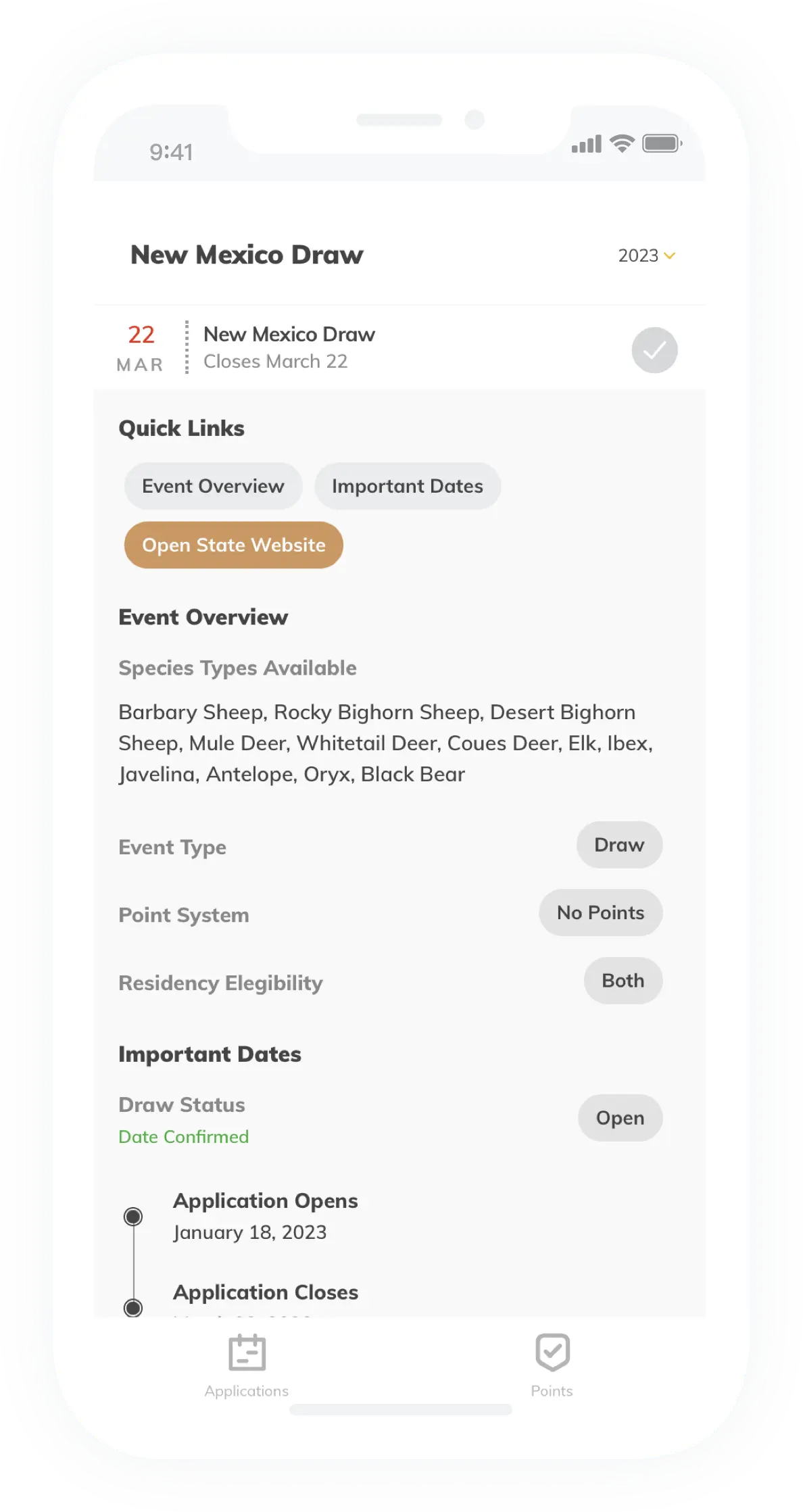Arizona Elk and Antelope Draw 2025
Update: The 2024 Arizona Elk and Antelope Draw is now closed. If you missed it you can start tracking draw deadlines for free with OnPoint, available on Apple App Store or Google Play Store.
Arizona Elk and Antelope Draw Overview
Arizona offers tremendous opportunity for both elk and antelope hunting, with high quality tags available for both species in the state. The annual Arizona elk and antelope draw is the primary opportunity to secure these tags for both resident and nonresident hunters. Managed by the Arizona Game and Fish Department (AZGFD), applications are typically due in early February and see high demand. Arizona uses a hybrid application system where a portion of tags are issued to max points holders (preference) and the remaining tags are issued on a bonus style system. In this article we will cover the main points of the draw, and how to successfully submit your application and maximize your chances of drawing.
Sale Date: When is the Arizona Elk and Antelope Draw?
The 2025 draw closes February 4th 2025, at 11:59pm Arizona Time. The open date has not been announced, but will be early to mid January.
The Arizona Elk and Antelope Draw typically opens in January and closes in early to mid-Frebruary. In 2024 AZGFD moved the draw dates up, from the second Tuesday of the month to the first. Results are usually announced in early to mid-March. The following table lists important dates for the 2025 application period. Click here to start tracking your apps for free.
| Event | Date |
|---|---|
| Online Application Opens | Early January |
| Deadline to Apply | February 4th, 2025 |
| Draw Results Expected | Mid March |
Draw requirements: What is required to apply in the draw?
To apply in the Arizona elk and antelope draw, you must possess a valid annual hunting license. In addition, you must pay an application fee for each species applied for. If applying for a bonus point only, you must pay the bonus point fee, which is the same as the application fee.
Tag prices: How much does a nonresident Arizona elk or antelope tag cost?
Prices for the required licenses and tags are summarized below.
General Fees
| Item | Resident Price | Non-Resident Price |
|---|---|---|
| Combo Hunt & Fish License | $57.00 | $160.00 |
| Application Fee (per species) | $13.00 | $15.00 |
| Bonus Point (per species) | $13.00 | $15.00 |
Species specific tag fees
| Item | Resident Price | Non-Resident Price |
|---|---|---|
| Elk Tag | $135.00 | $650.00 |
| Deer Tag | $45.00 | $300.00 |
| Pronghorn Tag | $90.00 | $550.00 |
| Rocky Mountain Bighorn Sheep Tag | $300.00 | $1,800.00 |
| Desert Bighorn Sheep Tag | $300.00 | $1,800.00 |
| Turkey Tag | $25.00 | $90.00 |
| Bear Tag | $25.00 | $150.00 |
| Javelina Tag | $25.00 | $100.00 |
| Bison – Bull/Any Tag | $1,100.00 | $5,400.00 |
| Bison – Cow/Yearling Tag | $650.00 | $3,250.00 |
| Bison — Yearling only Tag | $350.00 | $1,750.00 |
| Raptor Tag | $13.00 | $190.00 |
| Sandhill Crane (3 tags) | $30.00 | $30.00 |
Nonresident cap
Nonresident tags are capped at 10% of the total allocated. The allocated amount can be reached at any pass of the draw, at which stage tags for that hunt will no longer be available to nonresident applicants.
Application Strategy: How to apply in the Arizona elk and antelope draw
Draw applications are submitted online, through the AZGFD draw portal. Applicants will choose up to five hunt choices. The draw process is the same for all species in Arizona, and detailed in the FAQ at the end of this article. It is important to understand the draw process, as it will have a substantial impact on your odds. Below is a brief summary of the draw process.
- First pass: up to 20% of total tags are issued in this round, which is structured as a preference based round based on max points held. Only first and second choices apply, and the nonresident cap of 10% of total tags will apply if met.
- Second pass: all remaining tags are available, under a bonus style system. Only first and second choices are considered. Applications are processed in order of lowest number, then checked to see if their first choice is available. If so, it is awarded, and if not, the second choice is considered. If the second choice is not available, the application is unsuccessful. Nonresident caps again apply here when checking availability.
- Third pass: third through fifth choices are considered, again in order of applicant number. Generally few if any quality tags are available in this stage.
In general for any quality unit, only first and second choices will matter. In the case of many units for nonresidents, the 10% cap will be met in the first pass (preference based), so no tags may be available in the bonus sections (second and third pass).
Recommended nonresident application strategy
Nonresident applicants should first check a desired unit max points requirement relative to their points quantity. If the applicant is at or very near the max points level and has the potential to be drawn in the first pass, the should considered it for their first or second choice.
If an applicant is not near max points, they will not draw in the first pass. They should then see if the unit reaches the 10% nonresident cap in the first pass. If it does, there will be no tags remaining for them in the subsequent passes and should not be considered for either their first or second choices. If the unit does not meet the nonresident cap in the first pass, it could be considered in the second pass as a first or second choice.
Applicants without max points should generally put the lower odds unit first, but where tags will still be available in the second pass. They should put a higher draw odds unit (lowest quality tag that they would still be willing to draw and use your points) as your second choice. Since applications are considered one hunter at a time (rather than all first choices, then all second choices), overall odds for a hunter will generally be set by their second choice.
Few if any quality units are available in the third pass (3rd to 5th unit choices). If you are trying to build points, there is little value in adding choices here. If you add a low quality unit and draw it, you will lose your points. If you are at a low point quantity and are seeking opportunity over hunt quality, you can add choices here. You should only consider hunts that have 100% success odds in the first/second pass.
How to build bonus points in Arizona
Bonus points can only be acquired through the draw process. A point is awarded for an unsuccessful application, or applicants may choose a bonus point only in their application. The cost to acquire a point is the same via either method.
Alternate options to get tags in Arizona
Tags not issued in the draw, or more typically tags that are awarded but not purchased, are made available through a leftover tag sale. Tag numbers here are typically limited and/or from limited quality units, but do offer some opportunity to secure a tag.
If you are unsuccessful for elk or antelope, or would like to add additional tags, Arizona has a number of draws for different species or seasons. Below are all draws and sales that occur in Arizona.
| Event | Species | Opening | Deadline |
|---|---|---|---|
| Arizona Spring Hunts Draw | Bison, Black Bear, Turkey, Javelina | September 10, 2024 | October 1, 2024 |
| Arizona Non-Resident OTC Deer Tag Sale | Deer | November 4, 2024 | N/A |
| Arizona Elk and Antelope Draw | Elk, Antelope | Early January 2025 | February 4, 2025 |
| Arizona Fall Hunts Draw | Mule Deer, Coues Deer, Rocky Mountain Bighorn Sheep, Desert Bighorn Sheep, Bison, Black Bear, Turkey, Javelina | May 7, 2024 | June 4, 2024 |
Arizona Elk and Antelope Draw FAQ
In Arizona’s hunting draws, participants are eligible to accumulate an Arizona Loyalty Bonus Point for each species included in the draws. These points are distinct to each species and particular draw. An individual gains these points by consistently submitting a valid application for a hunt permit-tag or a bonus point for a specific species every year over a continuous five-year span. Once a loyalty bonus point is earned, it is maintained by the applicant as long as they continue to apply at least annually for that species. Importantly, even after a tag is drawn and the standard points are reset, the loyalty bonus point remains with the hunter.
Arizona offers a permanent Hunters Education bonus point to hunters who have completed the requirements to obtain it. By completing the requirements, detailed below, the hunter gets an additional point added to each entry in the draw, for any species or draw they apply for. If successful in a draw, the hunter will have 1 point already after point clearing.
There are two methods to obtain the Arizona Hunters Education Bonus Point.
- Take a Hunters Education Course sanctioned by Arizona, including the onsite field day for the course. While the coursework can usually be performed online, out of state hunters must travel to the state to perform the field day.
- Take the new Ethically Hunting Arizona online course and complete the tests successfully. This course allows the hunter to gain the permanent bonus point. However, it is not a hunters education course, so the hunter must already possess a valid hunters education to be eligible to hunt. This course costs $300 for nonresidents.
Only one permanent hunters ed bonus point can be acquired, even if both methods have been completed.
The Arizona draw process for big game hunts is a multi-phase system that offers hunters a fair chance to secure permits for various species like deer, antelope, elk, turkey, javelina, and bear. Here’s a breakdown of how the Arizona big game draw works:
Three Phases of the Drawing
The draw consists of three passes or rounds – the bonus point pass, the first-second choice pass, and the third-fourth-fifth choice pass. Each application goes through a random number generator program before each pass, which are reset and rerun after each pass.
Random Number Generation
For every application, a random number is generated, and additional random numbers are added for each group bonus point, including Hunter Education and Loyalty bonus points. The lowest random number for an application is used in the drawing. New random numbers are generated for each pass.
Group Bonus Points
Group bonus points come into play when 2 to 4 applicants apply on a single hunt application. These points are calculated by adding the general bonus points, loyalty bonus point, and hunter education bonus point for each applicant and dividing the total by the number of applicants. The average number of bonus points in the group is used in the draw.
Checking for Permit Availability
When an application is reviewed, the system checks for available permits in the chosen hunt. There must be enough permits for all applicants on the application, including non-resident caps. If not, the application is passed, and the next one is reviewed.
The Drawing Phases
First Pass (Bonus Point Pass)
In this pass, up to 20% of authorized hunt permit-tags are issued for various species. Applications are first sorted based bonus points, starting with maximum bonus and proceeding with fewer points after. Within each point grouping, e.g. holders with max points, applications are then sorted by the random number generated prior to the round, with lowest number being prioritized first. Applications from the prior ordering are then reviewed in order, and if permits are available, they are issued. In this round, only first and second choices are considered. The process continues with lower bonus point categories until the allocated permits are issued or all applications with bonus points are reviewed. Nonresidents are limited to 10% of total tags across all rounds. It is possible that this 10% limit is reach in the first pass, which means tags for that unit are no longer available to nonresidents, in any round. Applications with zero bonus points are not eligible in this round. Functionally, this proceeds as a preference based system.
Second Pass (First-Second Choice Pass)
Applications that didn’t succeed in the bonus point pass receive a new random number for the second pass round. This pass of the draw proceeds similar to a standard bonus point system, where each bonus point held improves the odds of receiving a low number in the number generation process. Applications are then reviewed in order of lowest number. For each application, if the first choice hunt is available, it is awarded. If it is not, the second choice is reviewed and awarded if available. If not, the system continues on to the next application. If the nonresident cap for a unit has been meet prior to a nonresident application, the unit will no longer be available to the applicant.
Third Pass (Third-Fourth-Fifth Choice Pass)
For applications unsuccessful in the first two passes, new random numbers are generated, and the system reviews applications in the same method as the prior pass, but considering third, fourth, and fifth hunt choices.
Awarding Bonus Points
After the third pass, the drawing concludes, and applicants who did not receive permits are awarded an additional bonus point for each species they applied for. These points are reset to zero for species where they received permits.
As of Jan. 1, 2022 trail cameras are no longer legal for use in hunting. Specifically, they are prohibited “for the purposes of taking or locating or aiding in the take of wildlife,” according to new rule R12-4-303. A. 5.




